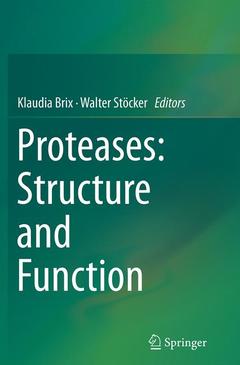Proteases: Structure and Function, 2013
Coordonnateurs : Brix Klaudia, Stöcker Walter

1 Protease families, evolution and mechanisms of action "Set the stage".- 1.1 Enzyme families, prototypes and catalytic mechanisms.- 1.2 Enzyme kinetics, mathematical modelling and perspectives.- 1.3 Structure determination and search for inhibitors.- 2 Regulation of proteolysis "Positioning and teaming-up to control activity".- 2.1 Compartmentalization of proteolysis.- 2.2 Biosynthesis of lysosomal proteases.- 2.3 Interactions of proteases and inhibitors / networking in the degradome.- 2.4 In vivo analysis of the protease and inhibitors concert.- 3 Proteases in development "Born to be right".- 3.1 Proteases for pattern formation during morphogenesis.- 3.2 Proteases in death pathways (apoptosis, necrosis).- 4 Proteases in physiology and pathophysiology „Cleave to function in health or to cause disease".- 4.1 Protein turnover and signaling functions (degrade to rebuild, remodel, process and mature for signalling).- 4.2 Proteases in control of physiology.- 4.3 Cancer: invasion and metastasis.- 4.4 Bacterial proteases.- 4.5 Viral proteases.
Written by designated experts in the field defined models are described
Ensures a better understanding of biological significance of proteinases
Clearly shows the diversity and networking of enzymes
Includes supplementary material: sn.pub/extras
Date de parution : 08-2016
Ouvrage de 564 p.
15.5x23.5 cm
Disponible chez l'éditeur (délai d'approvisionnement : 15 jours).
Prix indicatif 210,99 €
Ajouter au panierDate de parution : 02-2014
Ouvrage de 564 p.
15.5x23.5 cm
Disponible chez l'éditeur (délai d'approvisionnement : 15 jours).
Prix indicatif 210,99 €
Ajouter au panierThème de Proteases: Structure and Function :
Mots-clés :
enzyme; proteinase; proteinase function; proteinase structure; Protein Structure



